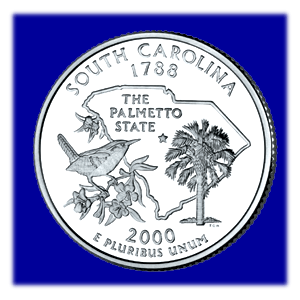remaining missing quarters.
The
South Carolina quarter was the eighth state quarter to be released by
the U.S. Mint. South Carolina became a state on May 23, 1788, and the
South Carolina quarter was the third one to be released in the year 2000.
The South Carolina Department of Parks, Recreation and Tourism chose this
design from the ideas given to them from school children in South Carolina
and from the South Carolina Numismatic Society. Governor Jim Hodges chose
the final design and recommended it to the Secretary
of the Treasury. The South Carolina quarter has pictures of three
state symbols on it: the bird, the flower, and the tree.
South Carolina adopted the Carolina wren as its state bird in 1948. The Carolina wren is about 5 and ½ inches tall. It has a rusty brown colored crown and body. The chin, throat, and lower cheeks are white. It is found in many southeastern states, but it can survive further north if the weather is mild. Carolina wrens eat insects, spiders, and tree frogs. It makes a three-syllable chirping sound.
South Carolina adopted the Carolina wren as its state bird in 1948. The Carolina wren is about 5 and ½ inches tall. It has a rusty brown colored crown and body. The chin, throat, and lower cheeks are white. It is found in many southeastern states, but it can survive further north if the weather is mild. Carolina wrens eat insects, spiders, and tree frogs. It makes a three-syllable chirping sound.

The Yellow Jessamine was adopted as the state flower of South Carolina
in 1924. This flower can be found all over South Carolina and throughout
many southeastern states. It is a climbing plant with shiny green leaves.
It is also called an evergreen vine. The Jessamine makes a small yellow
flower that blooms early in the spring. The flower is about one inch in
diameter and smells almost like Jasmine.
South Carolina adopted the Palmetto as its state tree in 1939. The Palmetto is a type of palm tree with fan-shaped leaves. Palmetto trees grow along the coast of South Carolina and are very important to South Carolina's history. On Sullivans's Island in South Carolina Fort Moultrie was built with Palmetto logs found growing in the area. American soldiers successfully defended this fort during the Revolutionary War. When the British warships fired cannonballs, they sunk into the tough soft wood but did not destroy the fort. This was an important victory for South Carolina's troops during the Revolutionary War, and this tree is a symbol of South Carolina's success in defending Sullivan's Island.
On this quarter there is also an outline map of South Carolina with a star showing the location of the capital city, Columbia. In 1786 this city was designed and named after Christopher Columbus. Before that time Charleston was the capital of South Carolina. Although Columbia was attacked and burned down during the Civil War, it was rebuilt. Over 100,000 people live there today.
South Carolina adopted the Palmetto as its state tree in 1939. The Palmetto is a type of palm tree with fan-shaped leaves. Palmetto trees grow along the coast of South Carolina and are very important to South Carolina's history. On Sullivans's Island in South Carolina Fort Moultrie was built with Palmetto logs found growing in the area. American soldiers successfully defended this fort during the Revolutionary War. When the British warships fired cannonballs, they sunk into the tough soft wood but did not destroy the fort. This was an important victory for South Carolina's troops during the Revolutionary War, and this tree is a symbol of South Carolina's success in defending Sullivan's Island.
On this quarter there is also an outline map of South Carolina with a star showing the location of the capital city, Columbia. In 1786 this city was designed and named after Christopher Columbus. Before that time Charleston was the capital of South Carolina. Although Columbia was attacked and burned down during the Civil War, it was rebuilt. Over 100,000 people live there today.